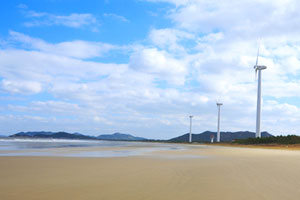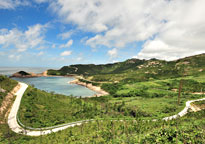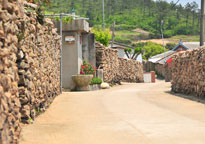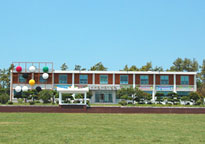
Bigeum-myeon, Shinan-gun
Beautiful Bigeum-myeon with Myeongsashipri of Rosa Rugosa in bloom
When getting off the ship at Bigeumdo, people can see the salterns covering the entire waterfront. Bigeumdo, famous for being a town of salt, started the Sea saltern for the first time in Korea. The name, bigeumdo, was given because its shape was similar to bird flying away. The island belongs to Dadohae National Marine Park and is one of a few islands that have mountains as well as coastlines with breathtaking views.

Hanoonum Heart Beach

Naechon Stone Wall Village

Lee Se-dol Baduk Memorial Hall
When getting off the ship at Bigeumdo, people can see the salterns covering the entire waterfront. Bigeumdo, famous for being a town of salt, started the Sea saltern for the first time in Korea.
Bigeumdo is located in the southwestern sea of Korea and 54.5km away from Mokpo (longitude 125。45" east and latitude 34。45" north). It faces eastward to Amtae/Palgeum/ Anjwa-myeons, westward to Heuksan-myeon, southward to Docho-myeon with a bridge connecting an island to the land and northward to Jaeun-myeon. It is composed of 4 inhabited islands and 76 uninhabited islands and the coastline is 86.4km long. East/west is long and north/south is short. Seongchi mountain range is stretched toward the east and Seonwang mountain range is stretched toward the west.
In between, east/west plains stretch and in the north, the sandy beach of Myeongsashipri is formed with the sands blown from the yellow sea. The shape of the island looks like bird's flying and it was named as Bigeumdo. The island belongs to Dadohae National Marine Park and is one of a few islands that have mountains as well as coastlines with breathtaking views.
The mysterious harmony of colorful rocks is compared to the beautiful view of Hongdo. There are three stones stretching their legs toward the sea and ladders are naturally generated on the stone. Shinan used to be believed to be a difficult place for producing Sea salts in the Japanese colonial period due to the heavy rainfall. However, Mr. Sam Man Park who was drafted to Jueul saltern in Yonggang-gun, Pyeonganname-do came back to the hometown after the liberation, blocked the mudflats and made 'Gurim saltern' as the first saltern in the area (1946). Up until then, in Jueul saltern and etc., the sale was made by boiling the sea water in a huge pot and thus, 'Gurim saltern' is the first Sea Salt saltern in Korea. The salt-making method adopted by Gurim saltern was spread to other islands in Shinan-gun.
In Bigeumdo, in 1948, 450-household residents formed 'Daedong saltern guild' and while eating barley rice cake and vegetable portage only, worked on the vast saltern over 100ha. Right after 5.16 coup, along with the currency reform, the price of salt soared to 800 KRW per a bag of salt and even the laborers of salterns had so much money in the wallets and the seams of the wallets were almost burst. Now, there are imported salts and chemical salts, so that the good economy became a story in the past, but anyway, in the past, the saltern business was booming and the name of island, 'Bigeumdo', also meant an island that 'money flies'.
Wonpyeong beach is known as the most beautiful beach in Bigeumdo. It has Rosa Rugosa blossoming red and beach with fine sands for the length of 10 ri. Thus, it is called Myeongsashipri (meaning renowned sand for 10 ri). Moreover, the sunset on the beach is so beautiful and breathtaking that it seems to drag viewers on the beach as well as the bright red sun to the sea. Hanuneom beach located in a quiet also shows off the beautiful scenery along with the surrounding rocky cliffs. Yongso of Bigeum, Girin-peak and Ddeokme-peak in Momdo and a tranditional Buddhist temple, Seosan temple are also worthy sight to see.
Goseo-ri has the algae nursery of Chilbaldo designated as natural monument No. 332 and as a historic site, there is Seongchi mountain fortress located on the tip of the hill to Dragon Cave in the mountain of Gangdae-ri. This stone-fortress was estimated to have been built during Koryo era with the height of 12m, area of 45.936㎡ and 130 layers of stones. It was said that before Mogolian soldiers invaded the area in 1231, the military training was conducted in the large land prepared below the fortress and the shouts and horseshoes were loud. Seongchi mountain fortress was almost demolished but until today, on the top of the fortress, Beacon Hill still remains to testify the old history. The beacon of Seongchi mountain fortress connected archipelago in the southwest sea of Korea in the past and received the beacon of Heuksan. The beacon continued to be passed on to Yudal mountain of Mokpo, Wangsan of Samhyang in Muan, Ongsan of Hampyeong, Gaeseong and Ganghwado and it was said that Bongjeong stayed here. In the southwest of the mountain fortress, there are a linn that a dragon used to live and went to the sky to avoid people's harassment and alongside, a clown village.
For folk play of Bigeum, Bamdarae play is famous. It is a ceremony to console the soul of the deceased and to pray for the easy passage into eternity and for the family that has propitious mourning of a person dying old and rich, villagers conduct this ceremony overnight at the house.
Bigeumdo is located in the southwestern sea of Korea and 54.5km away from Mokpo (longitude 125。45" east and latitude 34。45" north). It faces eastward to Amtae/Palgeum/ Anjwa-myeons, westward to Heuksan-myeon, southward to Docho-myeon with a bridge connecting an island to the land and northward to Jaeun-myeon. It is composed of 4 inhabited islands and 76 uninhabited islands and the coastline is 86.4km long. East/west is long and north/south is short. Seongchi mountain range is stretched toward the east and Seonwang mountain range is stretched toward the west.
In between, east/west plains stretch and in the north, the sandy beach of Myeongsashipri is formed with the sands blown from the yellow sea. The shape of the island looks like bird's flying and it was named as Bigeumdo. The island belongs to Dadohae National Marine Park and is one of a few islands that have mountains as well as coastlines with breathtaking views.
The mysterious harmony of colorful rocks is compared to the beautiful view of Hongdo. There are three stones stretching their legs toward the sea and ladders are naturally generated on the stone. Shinan used to be believed to be a difficult place for producing Sea salts in the Japanese colonial period due to the heavy rainfall. However, Mr. Sam Man Park who was drafted to Jueul saltern in Yonggang-gun, Pyeonganname-do came back to the hometown after the liberation, blocked the mudflats and made 'Gurim saltern' as the first saltern in the area (1946). Up until then, in Jueul saltern and etc., the sale was made by boiling the sea water in a huge pot and thus, 'Gurim saltern' is the first Sea Salt saltern in Korea. The salt-making method adopted by Gurim saltern was spread to other islands in Shinan-gun.
In Bigeumdo, in 1948, 450-household residents formed 'Daedong saltern guild' and while eating barley rice cake and vegetable portage only, worked on the vast saltern over 100ha. Right after 5.16 coup, along with the currency reform, the price of salt soared to 800 KRW per a bag of salt and even the laborers of salterns had so much money in the wallets and the seams of the wallets were almost burst. Now, there are imported salts and chemical salts, so that the good economy became a story in the past, but anyway, in the past, the saltern business was booming and the name of island, 'Bigeumdo', also meant an island that 'money flies'.
Wonpyeong beach is known as the most beautiful beach in Bigeumdo. It has Rosa Rugosa blossoming red and beach with fine sands for the length of 10 ri. Thus, it is called Myeongsashipri (meaning renowned sand for 10 ri). Moreover, the sunset on the beach is so beautiful and breathtaking that it seems to drag viewers on the beach as well as the bright red sun to the sea. Hanuneom beach located in a quiet also shows off the beautiful scenery along with the surrounding rocky cliffs. Yongso of Bigeum, Girin-peak and Ddeokme-peak in Momdo and a tranditional Buddhist temple, Seosan temple are also worthy sight to see.
Goseo-ri has the algae nursery of Chilbaldo designated as natural monument No. 332 and as a historic site, there is Seongchi mountain fortress located on the tip of the hill to Dragon Cave in the mountain of Gangdae-ri. This stone-fortress was estimated to have been built during Koryo era with the height of 12m, area of 45.936㎡ and 130 layers of stones. It was said that before Mogolian soldiers invaded the area in 1231, the military training was conducted in the large land prepared below the fortress and the shouts and horseshoes were loud. Seongchi mountain fortress was almost demolished but until today, on the top of the fortress, Beacon Hill still remains to testify the old history. The beacon of Seongchi mountain fortress connected archipelago in the southwest sea of Korea in the past and received the beacon of Heuksan. The beacon continued to be passed on to Yudal mountain of Mokpo, Wangsan of Samhyang in Muan, Ongsan of Hampyeong, Gaeseong and Ganghwado and it was said that Bongjeong stayed here. In the southwest of the mountain fortress, there are a linn that a dragon used to live and went to the sky to avoid people's harassment and alongside, a clown village.
For folk play of Bigeum, Bamdarae play is famous. It is a ceremony to console the soul of the deceased and to pray for the easy passage into eternity and for the family that has propitious mourning of a person dying old and rich, villagers conduct this ceremony overnight at the house.

